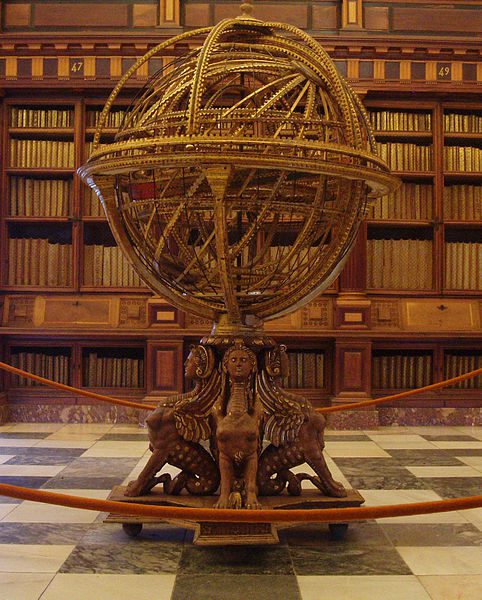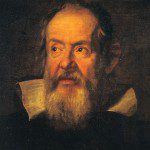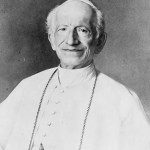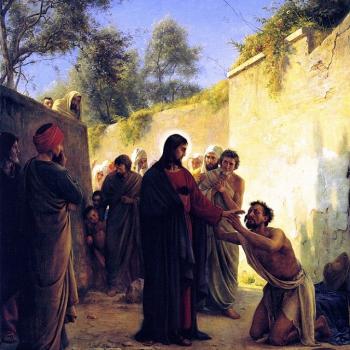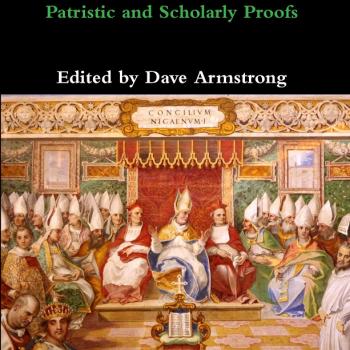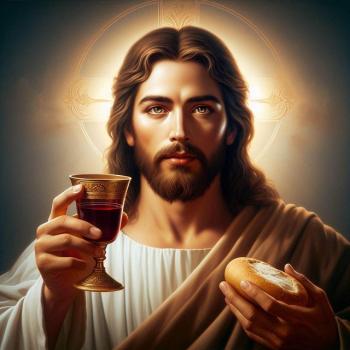* * *
In a momentous move, Clement of Alexandria (ca. 150-ca. 215) and his disciple Origen of Alexandria (ca. 185-ca. 254) laid down the basic approach that others would follow. Greek philosophy was neither inherently good nor bad, but was one or the other depending on how it was used by Christians. . . . Philosophy and science could be studied as “handmaidens to theology” . . . The handmaiden concept of Greek learning was widely adopted and became the standard Christian attitude toward secular learning. That Christians chose to accept pagan learning within limits was a momentous decision. . . . Their education was heavily infiltrated by Latin and Greek pagan literature and philosophy. . . . Christians realized that they could not turn their backs on Greek learning. (Edward Grant, The Foundations of Modern Science in the Middle Ages: Their Religious, Institutional and Intellectual Contexts [Cambridge, 1996], pp. 3-4)
On a spectrum of pagan values, from cosmic religion to Gnostic repudiation of the cosmos, the church fathers chose a middle position. There can be no doubt that biblical teaching about the creation as God’s handiwork was influential in determining where on the spectrum Christians would land, and therefore it is clear that their Christianity was highly relevant to the issue . . . It seems unlikely, therefore, that the advent of Christianity did anything to diminish the support given to scientific activity or the number of people involved in it. (David Lindberg, in Lindberg and Ronald Numbers, editors, God and Nature: Historical Essays on the Encounter Between Christianity and Science [Univ. of California Press, 1986], pp. 32-33)
Other historians have pointed out that although the Church Fathers subordinated the claims of science to the demands of faith, they rarely rejected Greco-Roman science and philosophy outright. . . . The dominant position was somewhere between that of Tertullian and Gregory [Nazianzus]: science and human reason in general were useful to the Christian as long as knowledge about the natural world never supplanted love of God or contradicted the tenets of religious belief. (Elspeth Whitney, Medieval Science and Technology [Greenwood, 2004], p. 5)
[T]he vast majority of Christian leaders looked favorably on the Greco-Roman medical tradition, viewing it as a divine gift, an aspect of divine providence, the use of which was legitimate and perhaps even obligatory. Basil of Caesarea (ca. 330-79) spoke for many of the church fathers when he wrote that “we must take great care to employ this medical art, if it should be necessary . . .”
[H]ow did the presence and influence of the Christian church affect knowledge of, and attitudes toward, nature? The standard answer, developed in the eighteenth and nineteenth centuries and widely propagated in the twentieth, maintains that Christianity presented serious obstacles to the advancement of science and, indeed, sent the scientific enterprise into a tailspin from which it did not recover for more than a thousand years. The truth, as we shall see, is dramatically different, far more complicated, and a great deal more interesting. . . .
Naturally enough, the kind and level of education and intellectual effort favored by the church fathers was that which supported the mission of the church as they perceived it. But this mission, interestingly, did not include the suppression of scientific investigations and ideas. . . .
If we compare the early church with a modern research university or the National Science Foundation, the church will prove to have failed abysmally as a supporter of science and natural philosophy. But such a comparison is obviously unfair. If, instead, we compare the support given to the study of nature by the early church with the support available from any other contemporary social institution, it will become apparent that the church was the major patron of scientific learning. Its patronage may have been limited and selective, but limited and selective patronage is a far cry from opposition. . . .
The contribution of the religious culture of the early Middle Ages to the scientific movement was thus primarily one of preservation and transmission. The monasteries served as the transmitters of literacy and a thin version of the classical tradition (including science or natural philosophy) through a period when literacy and scholarship were severely threatened. Without them, Western Europe would not have had more science, but less. (David Lindberg, The Beginnings of Western Science [Univ. of Chicago Press, 2nd ed., 2008], pp. 325 and 148-150, 156-157)
* * * * *
St. Clement of Rome (d. c. 101; pope) He accepted a good deal of Greek mathematics and astronomy, including belief that the earth was spherical. Unlike Aristotle, however, for him the earth was not eternal and it was sharply distinguished from the divine. Both the heavens and the earth were created and they were orderly: “the sun, the moon and the dancing stars . . . circle in harmony within the bounds assigned to them.” [source: Tripp]
St. Clement of Alexandria (c. 150-c. 215)
[T]he catechetical school of Alexandria . . . acquired the character of a Christian academy in which all Greek science was studied and made to do apologetic service in favour of the Christian cause. Under Clement and Origen it reached the acme of its renown . . .
(Otto Bardenhewer and Thomas Joseph Shahan, Patrology: The Lives and Works of the Fathers of the Church [Herder, 1908], p. 127; see also the citation from Edward Grant at the top of this paper)
Origen (c. 185-c. 254) He accepted the sphericity of the earth [source: Hannam: “The Myth of the Flat Earth”] See also the previous entry and citation from Edward Grant at the top of this paper.
St. Gregory Nazianzus (329-389; bishop and Doctor of the Church) He wrote:
For as we ought not to neglect the heavens, and earth, and air, and all such things, because some have wrongly seized upon them, and honour God’s works instead of God: but to real what advantage we can from them for our life and enjoyment . . . from the works of nature apprehending the Worker . . . as we know that neither fire, nor food, nor iron, nor any other of the elements, is of itself most useful, or most harmful, except according to the will of those who use it; and as we have compounded healthful drugs from certain of the reptiles; so from secular literature we have received principles of enquiry and speculation . . . (David Lindberg, in Lindberg and Ronald Numbers, editors, God and Nature: Historical Essays on the Encounter between Christianity and Science [Univ. of California Press, 1986], p. 29; citing The Panegyric on St. Basil: from the Schaff / Wace 38-volume translation of the Church fathers, vol. 7, 398-399)
St. Basil the Great (c. 330-379; bishop and Doctor of the Church) In contrast to Aristotle, he believed the heavens and the earth were made up of the same materials: earth, air, fire and water, and also questioned the Aristotelian view that divine spirits in the heavenly bodies must continue imparting motion directly to everything that moves. By analogy with a child’s top, he spoke of the heavenly bodies, “which after the first impulse, continue their revolutions, turning upon themselves when once fixed in their centre; thus nature, receiving the impulse of this first command, follows without interruption the course of the ages”. Basil’s spinning top provides an early formulation of the idea of impetus. His views on creation allow for the principle of the conservation of momentum, or of inertia, that appeared repeatedly in Christian thinkers over the next twelve centuries. [source: Tripp] He believed in a spherical earth. [source]
“If you observe carefully the members even of the animals, you will find that the Creator has added nothing superfluous, and that He has not omitted anything necessary.” He drew lessons from the migration of fish, the stealth of the octopus, the function of the elephant’s trunk, the behavior of dogs tracking wild animals, and the existence of both poisonous and edible plants. All play their designated role in nature, even poisonous plants, for as Basil argued, “there is no one plant without worth, not one without use. Either it provides food for some animal, or has been sought out for us by the medical profession for the relief of certain diseases.” Thus did Basil respond to those who wondered why God would create poisonous plants capable of killing humans. (Edward Grant, The Foundations of Modern Science in the Middle Ages: Their Religious, Institutional and Intellectual Contexts [Cambridge, 1996], p. 6; primary sources unable to be accessed in Google Reader)
St. Gregory of Nyssa (c. 335-c. 394; bishop) He wrote about the spherical earth:
As, when the sun shines above the earth, the shadow is spread over its lower part, because its spherical shape makes it impossible for it to be clasped all round at one and the same time by the rays, and necessarily, on whatever side the sun’s rays may fall on some particular point of the globe, if we follow a straight diameter, we shall find shadow upon the opposite point, and so, continuously, at the opposite end of the direct line of the rays shadow moves round that globe, keeping pace with the sun, so that equally in their turn both the upper half and the under half of the earth are in light and darkness. (On the Soul and the Resurrection)
St. Ambrose (c. 336-397; bishop and Doctor of the Church) He believed in a spherical earth. [source: Hannam: “The Myth of the Flat Earth”] [source]
[H]is work is full of observation of the facts of the natural world. He has minute descriptions of quails and storks and swallows, of bees and crickets, of trees and their modes of reproduction, of evaporation and the action of rain, of human anatomy and physiology. (Edward K. Rand, Founders of the Middle Ages [New York: Dover Publications, 1957; originally 1928, p. 93])
St. Jerome (c. 343-420; priest and Doctor of the Church) He referred to the earth as a “sphere” in his Letter 124 to Avitas (5).
St. Augustine (354-430; bishop and Doctor of the Church) He was the dominant thinker of the first thousand years of Christian history. For him, the universe, being the creation of God, was not eternal but finite in space and time. Time itself had its created beginning. . . . The Greek notion of cyclic returns was ridiculous, and eliminated the possibility of happiness. [source: Tripp] He wrote, about science and Scripture:
Usually, even a non-Christian knows something about the earth, the heavens, and the other elements of this world, about the motion and orbit of the stars and even their size and relative positions, about the predictable eclipses of the sun and moon, the cycles of the years and the seasons, about the kinds of animals, shrubs, stones, and so forth, and this knowledge he hold to as being certain from reason and experience. Now, it is a disgraceful and dangerous thing for an infidel to hear a Christian, presumably giving the meaning of Holy Scripture, talking nonsense on these topics; and we should take all means to prevent such an embarrassing situation, in which people show up vast ignorance in a Christian and laugh it to scorn. The shame is not so much that an ignorant individual is derided, but that people outside the household of faith think our sacred writers held such opinions, and, to the great loss of those for whose salvation we toil, the writers of our Scripture are criticized and rejected as unlearned men. If they find a Christian mistaken in a field which they themselves know well and hear him maintaining his foolish opinions about our books, how are they going to believe those books in matters concerning the resurrection of the dead, the hope of eternal life, and the kingdom of heaven, when they think their pages are full of falsehoods and on facts which they themselves have learnt from experience and the light of reason? Reckless and incompetent expounders of Holy Scripture bring untold trouble and sorrow on their wiser brethren when they are caught in one of their mischievous false opinions and are taken to task by those who are not bound by the authority of our sacred books. For then, to defend their utterly foolish and obviously untrue statements, they will try to call upon Holy Scripture for proof and even recite from memory many passages which they think support their position, although they understand neither what they say nor the things about which they make assertion. (From: The Literal Meaning of Genesis [De Genesi ad litteram libri duodecim], Bk. I, ch. 19, 39: translation by J. H. Taylor, in Ancient Christian Writers [Newman Press, 1982], volume 41, pp. 42-43)
In the same work (p. 33), Augustine refers to the spherical earth:
[T]here was nothing to prevent the massive watery sphere from having day on one side by the presence of light, and on the other side, night by the absence of light. Thus, in the evening, darkness would pass to that side from which light would be turning to the other. (Bk. I, ch. 12, 25)
And he wrote about the moon being illuminated by the sun:
[I]t is not the heavenly body itself that changes but the illumined surface of it. . . . it is always full, though it does not always appear so to the inhabitants of earth. The same explanation holds even if it is illumined by the rays of the sun. . . . It is only when it is opposite the sun that the whole of its illuminated surface is visible to us. (Bk. II, ch. 11, 31, pp. 68-69)
He rejected astrology (something that Galileo and Kepler still had not done 1200 years later). partially on the basis of observation of twins:
[L]et us . . . wholeheartedly reject all subtleties of astrologers and their so-called scientific observations . . . which they fancy established by their theories. . . . with headstrong impiety they treat evil-doing that is justly reprehensible as if God were to blame as the maker of the stars, and not man as the author of his own sins. . . .
What more absurd and stupid than, after assenting to the foregoing argument, to say that the influence and power of stars is only over the lives of men? Such a theory is refuted by the case of those twins that spend their lives in different circumstances, one prosperous and the other wretched . . .(Bk. II, ch. 17, 35-36, p. 71)
John F. McCarthy elaborates on St. Augustine’s positing of something not unlike theistic evolution:
This theory of primordial packages of forms later to emerge (often referred to by commentators as “seminal reasons”) is certainly developmental, but does not correspond with Darwinian evolution. Essential to Augustine’s theory is the idea that the order later to emerge was instilled by God in the beginning. Augustine also requires subsequent interventions by God to “plant” the forms whose “numbers” had already been instilled. Thus, as St. Thomas [Aquinas] points out, the ability of the earth to produce living forms was visualized by Augustine as a passive potency which disposed the matter to receive the forms but did not create the forms themselves. Augustine’s theory of primordial packages deserves more ample meditation and analysis in another place, especially with reference to theories of the development of living things, . . . Genesis 1:6-8 witnesses in several ways to the creative action of God. As the divine Fashioner of the universe, God guided the energies that He had invested in the primal matter by his creative intervention on the first day to bring the cosmos to its structured state. This is the unfolding of the active potency contained in St. Augustine’s “primordial packages.” But there is also implied in these verses an upward progress in the order of inorganic being which seems to have required additional creative divine interventions. (A Neo-Patristic Return to the First Four Days of Creation, Part IV; see also Parts One, Two, Three, Five, and Six)
See also, “How Augustine Reined in Science,” Kenneth J. Howell (This Rock, March 1998); Davis A. Young, “The Contemporary Relevance of Augustine’s View of Creation,” and Andrew J. Brown, “The Relevance of Augustine’s View of Creation Re-Evaluated” (PDF).
Paulus Orosius(c. 375-c. 418; priest) He believed in a spherical earth. [source]
Pope St. Leo the Great (c. 400-461; Doctor of the Church) He wrote:
Use these visible creatures as they ought to be used, as you use earth, sea, sky, air, springs and rivers; and praise and glorify the Creator for everything fair and wonderful in them . . . We are not, of course, . . . telling you this to persuade you to despise the works of God, or to think that there is anything against your faith in the things which the good God has made good; but so that you may use every kind of creature, and all the furniture of this world, reasonably and temperately. (David Lindberg, in Lindberg and Ronald Numbers, editors, God and Nature: Historical Essays on the Encounter between Christianity and Science [Univ. of California Press, 1986], p. 32; citing In nativitate Domini sermo VII)
Theodosius II (401-450) A non-literary but graphic indication that people in the Middle Ages believed that the Earth was a sphere, is the use of the orb (globus cruciger) in the regalia of many kingdoms and of the Holy Roman Empire. It is attested from the time of the Christian late-Roman emperor Theodosius II (423) throughout the Middle Ages. [source: Wikipedia: “Flat Earth”]
Procopius of Gaza (c. 465-528) He argued against life in the antipodes of the earth (the other side of the earth). In so doing, he presupposed that the earth was a sphere. [source: White, vol. 1, 104]
Anthemius of Tralles (c. 474-before 558) He collaborated with Isidore of Miletus to build the church of Hagia Sophia in Constantinople (what is today Istanbul in Turkey): the largest cathedral in the world for nearly a thousand years. He was also a capable mathematician. He described the string construction of the ellipse and he wrote a book on conic sections. Anthemius assumes a property of an ellipse not found in Apollonius work, that the equality of the angles subtended at a focus by two tangents drawn from a point, and having given the focus and a double ordinate he goes on to use the focus and directrix to obtain any number of points on a parabola—the first instance on record of the practical use of the directrix. [source: Wikipedia bio]
Isidore of Miletus (6th c.) He was one of the two architects (the other being Anthemius of Tralles) who designed the church of Hagia Sophia in Constantinople. He was also an able mathematician, to him we owe the T-square and string construction of a parabola. [source: Wikipedia bio]
Boethius(c. 480-524) He documented several ideas relating science to music, including suggestions of sound waves (comparing sound to the waves made by throwing a stone into the water) and the notion that pitch is related to the physical property of frequency:
[W]hen air is struck and produces a sound, it impels other air next to it and in a certain way sets a rounded wave of air in motion, and is thus dispersed and strikes simultaneously the hearing of all who are standing around.
[T]he same string, if it is tightened further, givers a higher pitched sound; if it is loosened, a sound of lower pitch. For when it is tighter it renders a swifter impulse and returns more quickly, striking the air more frequently and more densely. [sources: Encyclopedia Britannica; Marshall Clagett, Greek Science in Antiquity (Dover Pub., 2002, pp. 74, 151)] He regarded the Earth as a sphere (globus terrae) in the center of a spherical cosmos in his influential, and widely translated, Consolation of Philosophy. [source: Wikipedia: “Flat Earth”]
Cassiodorus (c. 485-c. 585; monk) He believed in a spherical earth. [source]
John Philoponus (c. 490-c. 570; aka John of Alexandria) [Monophysite] He was a professor in the school of philosophy in Alexandria, and the first to mount a devastating critique of the deductive method and much of the content of Aristotle’s physics and cosmology. There was no rival to its thoroughness until Galileo. For him, heavenly bodies were not animated beings, but were made of the same stuff as this world. The light from the stars was the same as that of glow-worms and luminescent fish. Astrology was rejected as pagan. Similarly, the heavenly bodies were not perfect. They did not move with regularity in the perfect shape of the circle – a simple matter of observation. The apparent changelessness of the universe did not mean that it is eternal. It had a beginning and will have an end. He rejected Aristotle’s view that heavier bodies fall faster than lighter ones (a thousand years before Galileo!). He declared, “Our view may be corroborated by actual observation more effectively than by any sort of verbal argument.” His theories on motion were the forerunner of the later theories of inertia and momentum that are embedded in Newton’s first law of motion. As regards nature, he stated that God, having finished the creation of the universe, “hands over to nature the generation of the elements one out of another, and the generation of the rest out of the elements.” That sounds like a summary of the evolution of the universe from basic materials that modern science would identify with. The relative autonomy of nature, with its own order and laws, is basic to science, and these early Christian thinkers were laying the foundations. . . . Galileo knew the key work of Philoponus, from a thousand years earlier. [source: Tripp] He accepted the sphericity of the earth [source: Hannam: “The Myth of the Flat Earth”] He understood light as something dynamical and that light and heat may best be explained as consequences of the nature of the sun, which is fire (In Meteor. 49). Heat is generated when the rays emanating from the sun are refracted and warm the air through friction. He concluded, against Aristotle, that there is in fact nothing to prevent one from imagining motion taking place through a void. As regards the natural motion of bodies falling through a medium, Aristotle’s verdict that the speed is proportional to the weight of the moving bodies and indirectly proportional to the density of the medium is disproved by Philoponus through appeal to the same kind of experiment that Galileo was to carry out centuries later (In Phys. 682-84). Philoponus insisted that a clear conception of the void is not only coherent but also necessary if one wants to explain movement in a plenum. When bodies move and in consequence exchange places, this presupposes that somehow there is empty space available to be filled by them (In Phys. 693f.). Again, there are certain phenomena which clearly exhibit the force of the vacuum, for example handling a pipette (clepsudra), which allows one to raise small quantities of fluids, or the fact that one can suck up water through a pipe (In Phys. 571f). Philoponus’ elaborate defense of the void (In Phys. 675-94) is closely related to his conceptions of place and space (In Phys. 557-85). The De opificio mundi has received some attention from historians of science, because Philoponus suggests at one point (I 12) that the movement of the heavens could be explained by a ‘motive force’ impressed on the celestial bodies by God at the time of creation. Philoponus compares the rotation implanted in the celestial bodies to the rectilinear movements of the elements as well as to the movements of animals: curiously, these are all understood as natural motions that are due to the creator’s divine impetus. In virtue of this bold suggestion Philoponus is often credited with having envisaged, for the first time, a unified theory of dynamics, since he strove to give the same kind of explanation for phenomena which Aristotle had to explain by different principles, depending upon their different cosmological contexts. [source: Stanford Encyclopedia of Philosophy: “John Philoponus”]
St. Isidore of Seville (c. 560-636; archbishop and Doctor of the Church) He believed in a spherical earth. [source] [second source: Hannam: “The Myth of the Flat Earth”] He taught in his widely read encyclopedia, the Etymologies, that the Earth was round and “resembles a wheel”. This was widely interpreted as referring to a flat disc-shaped Earth though some recent writers believe that he considered the Earth to be globular. [source: Wikipedia: “Flat Earth”] His other writings make it clear, however, that he considered the Earth to be spherical. He also admitted the possibility of people dwelling at the antipodes [the opposite side of the earth: a notion that presupposes sphericity]. [source: Wikipedia: “Spherical Earth”]
Paul of Aegina (c. 625-c. 690) He is considered by some to be the greatest Byzantine surgeon, developed many novel surgical techniques and authored the medical encyclopedia Medical Compendium in Seven Books. The book on surgery in particular was the definitive treatise in Europe and the Islamic world for hundreds of years, contained the sum of all Western medical knowledge and was unrivaled in its accuracy and completeness. The sixth book on surgery in particular was referenced in Europe and the Arab world throughout the Middle Ages and is of special interest for surgical history. The whole work in the original Greek was published in Venice in 1528, and another edition appeared in Basel in 1538. [sources: Wikipedia: “Paul of Aegena” and “Science in the Middle Ages”]
Venerable Bede (c. 672-735; monk and Doctor of the Church) He understood that the moon affects tides, and that high water was not simultaneous on all the coasts of Britain (recognition of the progressive wave-like character of tides). [source: David Edgar Cartwright, Tides: A Scientific History (Cambridge Univ. Press, 2001, pp. 13-14)] On the Reckoning of Time (De temporum ratione) included an introduction to the traditional ancient and medieval view of the cosmos, including an explanation of how the spherical earth influenced the changing length of daylight (“the roundness of the Earth, for not without reason is it called ‘the orb of the world’ on the pages of Holy Scripture and of ordinary literature.” — section32), of how the seasonal motion of the Sun and Moon influenced the changing appearance of the New Moon at evening twilight, and a quantitative relation between the changes of the Tides at a given place and the daily motion of the moon. [source: Wikipedia bio and Wikipedia: “Flat Earth”] Bede was lucid about earth’s sphericity, writing “We call the earth a globe, not as if the shape of a sphere were expressed in the diversity of plains and mountains, but because, if all things are included in the outline, the earth’s circumference will represent the figure of a perfect globe… For truly it is an orb placed in the center of the universe; in its width it is like a circle, and not circular like a shield but rather like a ball, and it extends from its center with perfect roundness on all sides.” [source: Wikipedia: “Spherical Earth”]
Saint Boniface (c. 672-754) He argued against life in the antipodes of the earth (the other side of the earth). In so doing, he presupposed that the earth was a sphere. [source: White, vol. 1, 104]
Vergilius of Salzburg (aka Fergal) (c. 700-784; bishop) He was an early astronomer and believed in a spherical earth. [source]
Charlemagne (c. 742-814; Roman emperor)
Charlemagne . . . and his great minister, Alcuin [c. 740-804], not only promoted medical studies n the schools they founded, but also made provision for the establishment of botanic gardens in which those herbs were especially cultivated which were supposed to have healing virtues. (from White, vol. II, 34)
Theodulf of Orléans (c. 750 to 760-821; bishop) He believed in a spherical earth. [source] A recent doctoral dissertation regarding medieval concepts of the sphericity of the Earth noted that no significant cosmographer since the eighth century has questioned the sphericity of the earth. [source: Wikipedia: “Flat Earth”]
Dicuil (late 8th c.; monk) He was an early astronomer and believed in a spherical earth. [source]
Rabanus Maurus (c. 780-856; archbishop) He believed in a spherical earth. [source] Isidore’s disc-shaped analogy continued to be used through the Middle Ages by authors clearly favouring a spherical Earth, e.g. the 9th century bishop Rabanus Maurus who compared the habitable part of the northern hemisphere (Aristotle’s northern temperate clime) with a wheel, imagined as a slice of the whole sphere. [source: Wikipedia: “Spherical Earth”]
Hunayn ibn Ishaq (also Hunain or Hunein; 809-873) [Nestorian] His monumental developments on the eye can be traced back to his innovative book, Ten Treatises on Ophthalmology: the first systematic book in this field. He explained in minute details about the eye, its diseases and their symptoms and treatments, and its anatomy – all possible by his extensive research and observations. For example, ibn Ishaq taught what cysts and tumors are and the swelling they cause, how to treat various corneal ulcers through surgery, and the therapy involved in repairing cataracts. [source: Wikipedia bio]
Johannes Scotus Eriugena (c. 815-c. 877) [universalist] He believed in a spherical earth. [source]
Remigius of Auxerre (c. 841-908; Benedictine monk) He believed in a spherical earth. [source]
Alfred the Great (849-899; Anglo-Saxon king). He believed in a spherical earth. [source]
Pope Sylvester II (born Gerbert d’Aurillac) (c. 940-1003) As a scientist, was said to be far ahead of his time. Gerbert wrote a series of works dealing with matters of the quadrivium (arithmetic, geometry, astronomy, music), which he taught using the basis of the trivium (grammar, logic, and rhetoric). He is said to have introduced the use of Arabic figures into Western Europe, and to have invented the pendulum clock. In Rheims, he constructed a hydraulic-powered organ with brass pipes that excelled all previously known instruments, where the air had to be pumped manually. Gerbert reintroduced the astronomical armillary sphere to Latin Europe via Al-Andalus in the late 10th century as a visual aid for teaching mathematics and astronomy in the classroom; also the abacus. The polar circle on Gerbert’s sphere was located at 26 degrees, just several degrees off from the actual 23° 28′. His positioning of the Tropic of Cancer was nearly exact, while his positioning of the equator was exactly correct. [bio sources: Wikipedia, Catholic Encyclopedia]
Notker Labeo (c. 950-1022; Benedictine monk) He believed in a spherical earth. [source]


